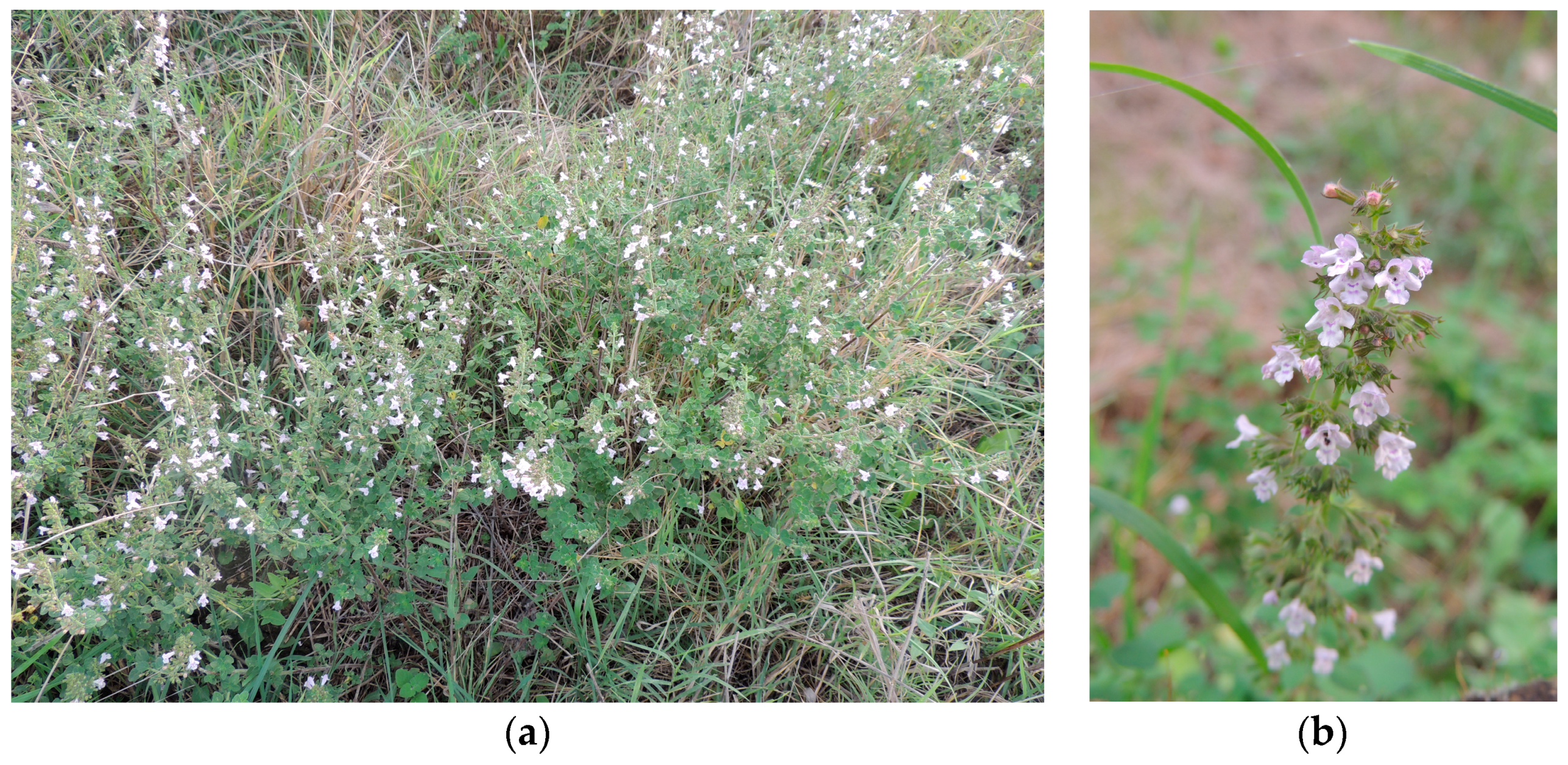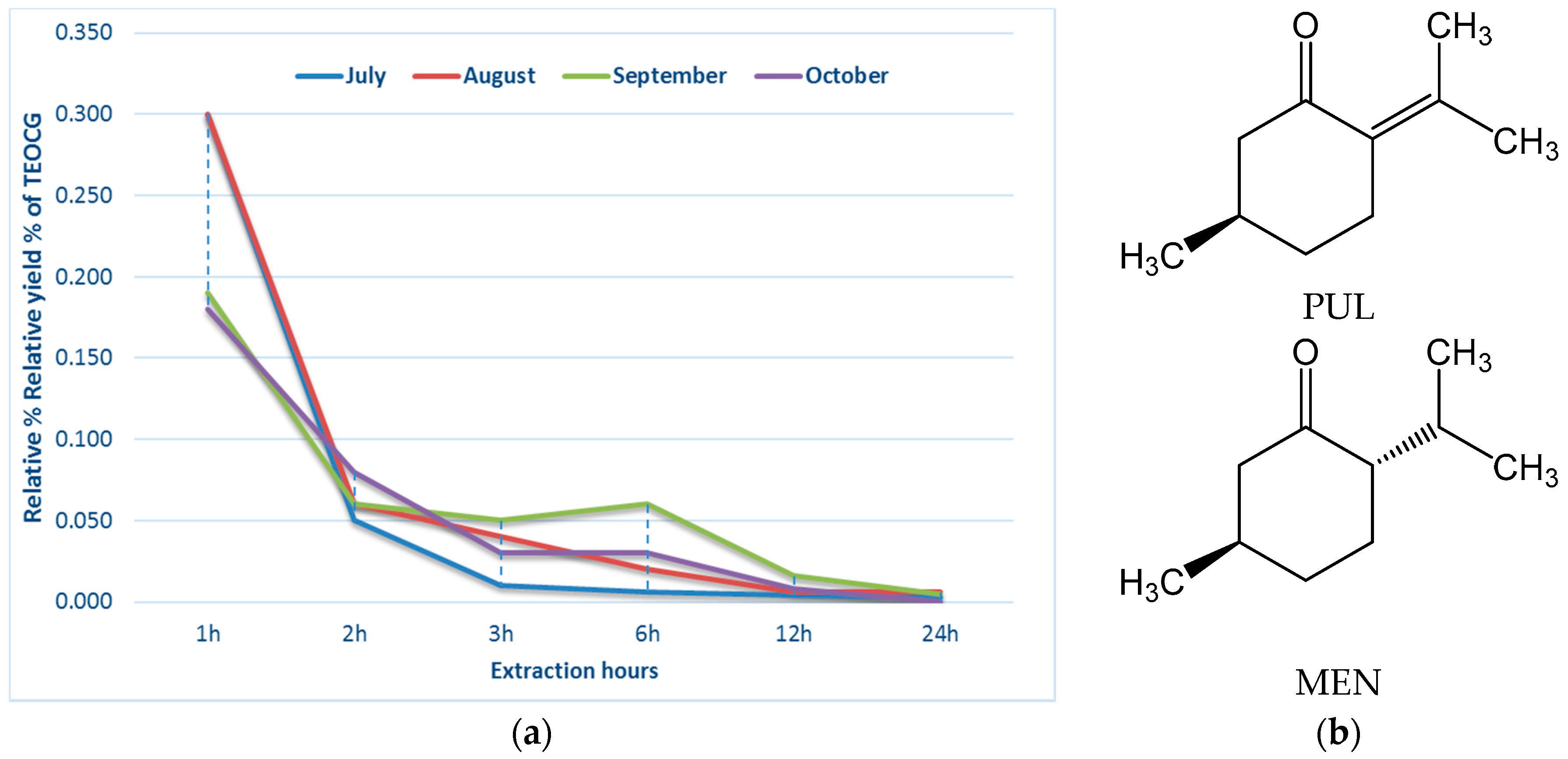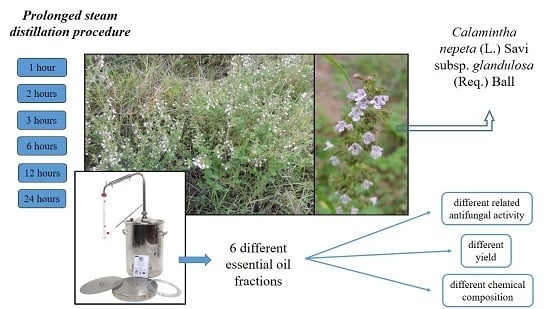2.2. GC/MS Analysis
The GC/MS analysis of the 44 TEOCG samples highlighted the presence of 39 different chemical constituents, having different concentrations in the various fractions (
Table 2,
Table 3,
Table 4 and
Table 5 and
S1–S4 of Supplementary Materials). In general, PUL (
36) was the most abundant component. Based on the extraction time in the July and August harvest, PUL percentage reached the maximum during the first three hours (J2h, A2h) whereas it diminished during the last three extractions. In the reproductive period of September and October, PUL percentage reached the maximum between the third and sixth (S6h) or twelfth hours (O12h). In all cases, PUL never disappeared and was present in smaller amounts in the last three fractions. It was particularly abundant in the August (84.7%) and July harvest (77.7%) samples. These findings are in compliance with previous reports [
11,
12,
13,
14,
17,
21,
22,
26,
28,
29,
31,
32,
33,
34]. PUL is a monoterpene ketone (
Figure 2b) with a fresh odor reminiscent of mint, found in many Lamiaceae species. It was first isolated from the EO of
Mentha pulegium L. from which its name was derived. This colorless liquid is very low soluble in water (less than 1%), but miscible with organic solvents such as ethanol, diethyl ether and chloroform. Biochemically, PUL is derived from terpinolene through piperitenone, and it is also the precursor of MEN, isomenthone and isopulegone [
35] and is usually encountered in combination with one or more of the mentioned compounds [
36].
The appearance of other constituents is related to the extraction time, but some of them are always present in significant amounts. For instance, MEN (
26) was present in each fraction (except J24h) and each month. Its percentage in the July harvest was important only in the first fraction (J1h), while in the August harvest its presence is significant also in the next two fractions (up to three hours of the extraction process). September and October harvest materials were characterized by a substantial increase of MEN (up to 35.4% in O1h), particularly in the first three hours, displaying almost 10 times the amount obtained from the plant collected in July and August. The substantial presence of MEN (
Figure 2b) in the CG oils has already been reported [
12,
13,
14,
21,
22,
34], sometimes up to 60% [
11]. According to results of the GC/MS analysis, samples from Tarquinia clearly belong to the PUL/MEN chemotype. However, the PUL/MEN ratio is influenced by the growth stage of the plant, with the greatest increase of MEN% during the fruiting period (October). This evolution of EO composition with the growth of the plant is somehow in good compliance with the report on EO from Corsica [
11].
Crysanthenone (CRY,
17) gradually increases its amount with the extraction time. In the July harvest, its percentage was from 4.4% to 20.3% in the first three hours (J1h–J3h) up to 33.9% in the twelfth extraction hour (J12h). The same compound in the August harvest increased from 2.6% to only 9% in the first three fractions (A1h–A3h) and then rapidly increased two times between the third and sixth hours up to 29.5% in the last fraction (A24h). It can be noticed that CRY is present at higher percentage in the July harvest and August harvest, than in flowering and fruiting periods when the maximum was 18.6% and 13.4% (S24h and O24h). This chemical compound was not reported to be an important constituent of CG oils. There are only few reports about its occurrence [
33] and none is even close to the percentage found in TEOCG, indicating that the Tarquinia plants belong to a PUL/MEN chemotype variant. Considering the average distillation process duration (usually up to two–three hours) in most cases, CRY un-detection is not surprising, as it becomes significant between 3 and 6 h of extraction. On the other hand, this compound is believed to be dependent on undergoing thermal and hydrolytic reactions during the hydro distillation process [
37], possibly explaining the percentage increase with the time of extraction.
Limonene (LIM,
19) is the characteristic component of the first fraction (and exceptionally in the second) of each month (J1h, A1h, S1h and O1h), reaching the maximum percentage (13.6%) in the flowering material gathered in the September harvest as described in previous reports [
11,
13,
14,
19,
21,
22,
31,
32,
33]. As a part of each CG chemotype, LIM could be considered as the common component, likely responsible for the plant fragrance [
32]. Regarding other chemical components, some compounds are present only in particular fractions, such as methylisopulegone (
27) in J24h (12.6%). Some others are characteristic of specific months: e.g.,
p-cymene (
7) is present only in the August harvest, while germacrene D (
20) and α-terpineol (
38) are only found in the July harvest. Caryophyllene oxide (
14) is missing only in the July harvest, while linalool (
24) is not present in the EOs during reproductive periods. On the other hand, piperitenone (
30) appears in the blooming period (August–September) and disappears in the October harvest, notably increased in amount in the last fractions (S6h, S12h and S24h). Piperitenone oxide (
31) was detected only in the September and October harvest EOs, reaching the higher quantities in the fruiting period (O3h to O24h). These observations prove that some constituents are characterizing compounds in reproductive periods.
In general, the complexity of the TEOCG chemical composition was more or less the same in the first three months (from 19 to 22 compounds), and rapidly decreased in the October harvest with just 13 different chemical constituents.
In order to simulate continuous EO extraction, the 1, 2, 3, 6, 12 and 24 h fractions were combined to generate EOs as there would have been extracted in single runs of 2, 3, 6, 12 and 24 h (
Supplementary Materials Tables S1–S4). The mixtures were prepared by hand and, taking into account the respective yields, reflect quite well the compositions of the original fractions, and were checked by GC/MS analyses for consistency. PUL was still the main characterizing compound, with MEN in the last two months. However, some deviations could be observed: the first mix from the October harvest (OM1,
Table S4) is characterized by a very high percent of MEN (not so high in the original fractions) and quite a low percentage of PUL (in comparison with the original fractions). This occurrence could be explained by some mistake during the mixing process.
It can also be noticed that some compounds are missing in the mixtures, making them simpler than the original fractions. For instance, linalool (24), α-terpineol (38) and cinerolone (15) in the July harvest and caryophyllene oxide (14) in the October harvest.
2.3. Anti-Candida Activity
The in vitro antifungal activities of TEOCGs extracted at different times and in different months, against
Candida albicans (ATCC 10231), are reported in
Table 6. The anti-
Candida efficacy was compared to that of miconazole (minimum inhibitory concentration (MIC) = 0.016 mg·mL
−1), a well-known antifungal synthetic drug, and to that of solvent used to dilute the oils as blank (RPMI 1640 supplemented with Tween 80) that has no activity against
Candida. The results are representative of two independent experiments (24 and 48 h of incubation) arranged in triplicate. With few exceptions, the MIC of this strain ranged from 6.24 mg·mL
−1 to 12.48 mg·mL
−1 for TEOCG extracted in the July and October harvest, and from 3.12 to 12.48 mg·mL
−1 for TEOCG extracted in the August and September harvest. Notably, some extracts showed an interesting and significant antifungal activity with MIC ranging from 0.78 to 1.56 mg·mL
−1.
Usually, the third fraction (between the second and third hours of extraction) showed good activity (J3h, A3h) or even the fourth one (between the third and sixth hours) in the case of the September harvest (S6h). In the case of mixtures, significant activity was detected for the third or fourth mix (JM3, AM3, SM3 and SM4). On the contrary, the October harvest was lacking any significant activity.
A survey of the available literature highlighted that most of the data about antimicrobial activity are related to CN [
21,
26,
38], but not to the subspecies investigated in this paper. To the best of our knowledge, the only data reported for CG was from the Montenegrin material [
22] and from Turkey [
23,
39]. The EO was screened against the following bacteria:
Escherichia coli,
Staphylococcus aureus,
Salmonella enteritidis,
Bacillus subtilis,
Pseudomonas aeruginosa and fungi
Aspergillus niger. All the microorganisms (except
S. enteritidis) were found to be susceptible, specifically
A. niger [
22]. Antimicrobial activity of the Turkish sample was evaluated, using the disc diffusion method, and the study showed that all the bacteria (particularly
B. subtilis,
Staphylococcus epidermidis,
Stenotrophomonas maltophilia) and
C. albicans were affected by the EO. In the study, the occurrence was explained by the high percentage of PUL [
23]. In addition, different CG extracts and fractions were investigated against Gram(+)
B. subtilis and Gram(−)
E. coli and
Salmonella typhimurium [
39]. The analysis showed better activity of the water extract than the methanol one, whereas the fractions prepared had greater bactericidal efficacy, especially the dichloromethane one. However, methanolic extract and the ethyl acetate fraction failed to inhibit all tested bacteria.
The contribution of some pure constituents to the EO effectiveness has also been evaluated [
21]. The main constituents of TEOCG were analyzed, and the only one endowed with antibacterial effectiveness was PUL. The authors indicated that the effectiveness of the essence was almost exclusively due to that constituent [
21]. The results indicate that PUL is likely not the only chemical component responsible for the antifungal activities, although it is always the dominant one, on the other hand, this is just an observation as advanced chemometric and statistical analyses need to be carried out. Looking at
Tables S1–S4, it is evident that other minor constituents are capable of microbiological activity as well and might be involved in the inhibition process with some synergistic mechanism resembling the one recently described [
8]. This is in compliance with the phytocomplex hypothesis discussed elsewhere [
40,
41]. Further analysis of data indicates the lack of any significant correlation between the antimicrobial activity and the vegetative stage of the plant (
Table 6). However, this is in contrast with some literature data which indicate the highest antimicrobial efficacy of EOs obtained during the blooming period of a plant [
42,
43,
44].









